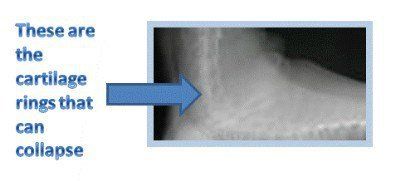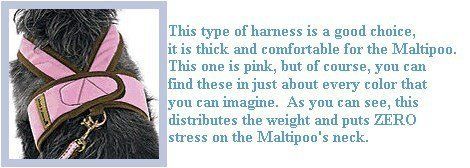Collapsed Trachea with the Maltipoo

Overview
A collapsed trachea happens most often to toy and small dog breeds due to their size, this would include the Maltipoo...while this dog is not AKC recognized, its size
would make it a toy breed dog. It is the size of the Maltipoo that makes it susceptible to this condition. And while this can happen due to a genetic weakness, with proper care, it can be avoided in many cases.
What This Is
A dog's neck is held together by rings of cartilage. They surround the entire inside of the neck, top to bottom. When they are in place, the dog can breath and eat without any problems. Certain actions can cause a ring or rings of this cartilage to "collapse", which means that they break inward or in severe cases, completely fall apart.
This then causes the dog moderate to severe pain, causes breathing problems (sometimes very severe) and can cause problems with swallowing. The rings may be weak due to a genetic weakness that is passed down; and in those cases the cartilage will soften over time, losing their stability. For these dogs, trauma to the neck can trigger this to happen.
Even if a dog does not have that genetic trait passed down to him, the rings can collapse if too much force is put on the neck over an extended amount of time or in some cases, it will be an acute injury due to a severe case of neck tension.
How This Happens
Dogs that are prone to this due to soft, weak rings may start to have issues as they mature. However, in most cases it will be pressure on the neck that causes this to happen, regardless of whether or not the dog is predisposed.
When too much stress is put on the Maltipoo's neck, the rings can collapse. It is sad that many owners do not realize how easy it is to avoid this from happening. In the majority of cases, the happens when the dog has a collar put on them, and then that collar is attached to a leash. When wearing the collar, all it takes is a moment in which the dog lunges forward or tries to take off running and the owner is caught off guard, unable to keep up....That one "jerking" motion is all it takes to cause Collapsed Trachea. And then, there is no turning back.
Alternatively, it may not be just one event; it can be a slow, gradual yet constant 'wearing down' as the dog experiences tension to the neck over the course of months or years.
Puppies
that are not yet trained to listen to all commands are most susceptible to this. It is very normal for a puppy to be outside, see a butterfly or flying insect and instinctively leap forward to try and catch it. If the Maltipoo is wearing a dog collar and is connected to a leash, if they jump with force and the leash stops them mid-action, all the stress of their jump is put directly onto the neck...and that is what causes this.

Yes! These dogs are being correctly walked with harness vests (and cute ones at that!) Many clothing for toy breeds come with leash connectors sewn into the fabric in the back, between the shoulder blades.
Sophie and Maddie, 6 month old littermate sisters
Photo courtesy of Melanie Smith
Signs and Symptoms
Coughing - The most common sign is a honking type cough. This typically is worse when the dog exercises, gets excited and/or when out during hot, humid weather.
Trouble eating or drinking - A dog may struggle to eat or drink as he coughs, chokes and/or cannot breath properly while doing so.
Breathing noises - There may be a wheezing or similar type of unusual breathing sounds.
Diagnosis
When the cough is severe and often, an experienced veterinarian will suspect collapsed trachea immediately; especially since it is so common with toy and small breeds. However, x-rays will be taken to confirm this.
Treatment
The usual treatment consists of a combination of medications to quite the cough (which irritates an already injured area) and medicines to help with swelling. A dog may be given a cough suppressants, bronchodilators, corticosteroids, and in some cases will be given antibiotics. Though these treatments cannot restore the rings back to their full strength and integrity, a detailed study has shown this treatment to be effective enough for dogs to live quality lives in 70% of cases.
For those that do not respond well or have re-occurring issues, surgery is recommended. In some severe cases, breathing can be so difficult that the dog has little quality of life; this is especially true for seniors.

Prevention
The answer is quite simple and causes zero discomfort for the dog. In fact, it can be an excellent fashion statement and look just adorable on the Maltipoo. The answer is to put a dog harness onto your Maltipoo instead of a dog collar. This should be a normal, expected aspect of puppy care.
A dog collar can still be used for identification purposes. However, a harness should always be used when walking your Maltipoo (or any toy or small sized dog). It should be used any time that your Maltipoo is connected to his or her leash.
When the harness is used, it distributes the weight and stress across the pup's or dog's chest areas shoulders and back; Then, if your dog jumps, lunges or other, the stress is not directed to any one particular area of their body. You can walk your dog, tug on the leash, let him run ahead (though not recommended) without injury.
As people are learning about the importance of this, harnesses are becoming very popular. You can find them in any size (just about every one is adjustable) and they come in many different materials and many different styles. If you are not sure which harness to obtain, you may wish to look to "Accessories" on the Maltipoo Supplies
page.

